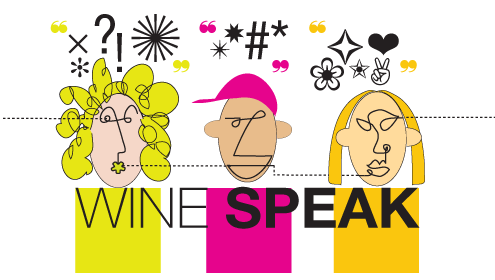WE NEED A BETTER WAY TO TALK ABOUT WINE!
Traditional winespeak – the language used by wine writers – may impress some, but for most, it’s meaningless, and even off-putting. Most importantly it does not deliver what it promises to, which is to tell us what to expect from a wine. Endless list of flavours and other components such as acids, tannins and finish only address what’s easy to measure – a mug-shot, in police language. Imagine how useless a concert review would be that just told you which instruments were played and what the drummer wore! Here is an example of how many experts describe a wine.
“Lifted by a hit of potpourri, its complex, creamy, and faintly meaty bouquet of red cherries and underbrush reveals undertones of orange rind and mushrooms. It’s long and crackly, with an austere but chewy palate of punchy Pinot driven flavor extending long and faintly mineral over a fine, chalky spine towards a drying and savoury finish”.
Flowery and poetic, and I think he liked it, but do you get a sense of where or when you might serve the wine?
Experts fail to get to the heart of a wine, because they’re too busy dissecting. And showing-off. They ignore the personality and the feeling you would have while drinking the wine. What would the experience be like? Wine, like music, is an emotional experience – something we feel. Therefore Winespeak should paint a word picture of the experience – possibly using a metaphor or analogy to create images in our imagination. The more vivid the picture, and the simpler the language, the better sense we’ll have of the wine. We’ll see what the writer felt, and where the wine might fit into our lives, or not.
GUIDELINES FOR A BETTER WINESPEAK
To help you get started take a look at my Wine Spectrum and read about Wine by Mood
 1. ESTABLISH THE CATEGORY: The first thing to do when you drink a wine is to place it in one of the categories on my Wine Spectrum Chart. This defines the wine’s purpose/vibe and what it’s good at! To use a music analogy, is it jazz, pop, classical, etc? The best way to identify the category is to concentrate on the overall feeling of the wine. Don’t analyze, don’t think – just feel. The wine will unveil its category, it will tell you what it’s about, just as music does.
1. ESTABLISH THE CATEGORY: The first thing to do when you drink a wine is to place it in one of the categories on my Wine Spectrum Chart. This defines the wine’s purpose/vibe and what it’s good at! To use a music analogy, is it jazz, pop, classical, etc? The best way to identify the category is to concentrate on the overall feeling of the wine. Don’t analyze, don’t think – just feel. The wine will unveil its category, it will tell you what it’s about, just as music does.
2. IMAGINE A CONTEXT: Now we move on to putting the wine into a context – a situation where the wine might shine, and bring something to the moment.
“I can see myself having this wine . . . ” You’re now shifting the focus off the wine and on to its use, just as you do when buy nice clothing. “I can see myself wearing this . . . ”
NOTE: While you may not enjoy the wine at the moment of tasting, can you see it appealing in another situation? Be fair in your judgement.
3. THE FULL STORY: You’re now ready to paint a word picture of the experience, incorporating the category and a context. You may want to use Colours (to suggest a feeling), Music or any analogy (cars, books, places, fabric), Human characteristics (serious, playful, gentle, loud, soulful, charming, pleasant, sexy, wild, etc.). Let your imagination fly.
Would what you have written about the wine help someone make a buying decision?
SHORT FORM “Hello wine, what’s your game? How can we have fun together? if not now, maybe at another time?”

